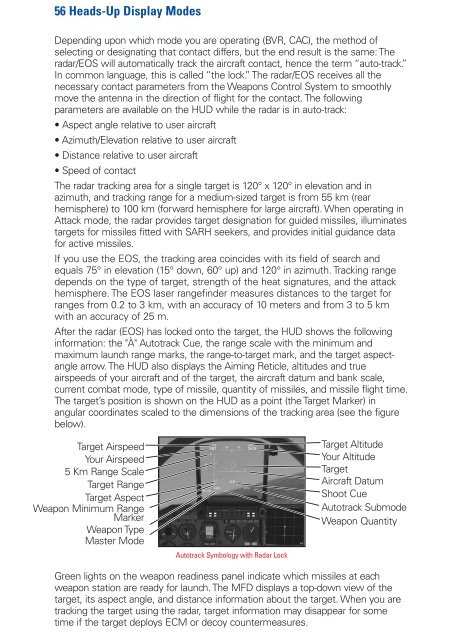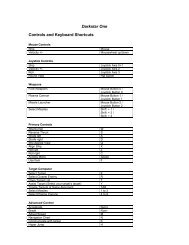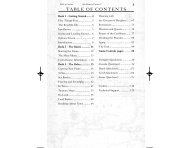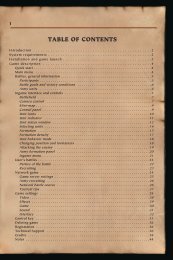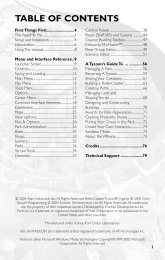Heads-Up Display Modes 35 - Metaboli
Heads-Up Display Modes 35 - Metaboli
Heads-Up Display Modes 35 - Metaboli
You also want an ePaper? Increase the reach of your titles
YUMPU automatically turns print PDFs into web optimized ePapers that Google loves.
56 <strong>Heads</strong>-<strong>Up</strong> <strong>Display</strong> <strong>Modes</strong><br />
Depending upon which mode you are operating (BVR, CAC), the method of<br />
selecting or designating that contact differs, but the end result is the same: The<br />
radar/EOS will automatically track the aircraft contact, hence the term “auto-track.”<br />
In common language, this is called “the lock.” The radar/EOS receives all the<br />
necessary contact parameters from the Weapons Control System to smoothly<br />
move the antenna in the direction of flight for the contact. The following<br />
parameters are available on the HUD while the radar is in auto-track:<br />
• Aspect angle relative to user aircraft<br />
• Azimuth/Elevation relative to user aircraft<br />
• Distance relative to user aircraft<br />
• Speed of contact<br />
The radar tracking area for a single target is 120° x 120° in elevation and in<br />
azimuth, and tracking range for a medium-sized target is from 55 km (rear<br />
hemisphere) to 100 km (forward hemisphere for large aircraft). When operating in<br />
Attack mode, the radar provides target designation for guided missiles, illuminates<br />
targets for missiles fitted with SARH seekers, and provides initial guidance data<br />
for active missiles.<br />
If you use the EOS, the tracking area coincides with its field of search and<br />
equals 75° in elevation (15° down, 60° up) and 120° in azimuth. Tracking range<br />
depends on the type of target, strength of the heat signatures, and the attack<br />
hemisphere. The EOS laser rangefinder measures distances to the target for<br />
ranges from 0.2 to 3 km, with an accuracy of 10 meters and from 3 to 5 km<br />
with an accuracy of 25 m.<br />
After the radar (EOS) has locked onto the target, the HUD shows the following<br />
information: the "À" Autotrack Cue, the range scale with the minimum and<br />
maximum launch range marks, the range-to-target mark, and the target aspectangle<br />
arrow. The HUD also displays the Aiming Reticle, altitudes and true<br />
airspeeds of your aircraft and of the target, the aircraft datum and bank scale,<br />
current combat mode, type of missile, quantity of missiles, and missile flight time.<br />
The target’s position is shown on the HUD as a point (the Target Marker) in<br />
angular coordinates scaled to the dimensions of the tracking area (see the figure<br />
below).<br />
Target Airspeed<br />
Your Airspeed<br />
5 Km Range Scale<br />
Target Range<br />
Target Aspect<br />
Weapon Minimum Range<br />
Marker<br />
Weapon Type<br />
Master Mode<br />
Autotrack Symbology with Radar Lock<br />
Target Altitude<br />
Your Altitude<br />
Target<br />
Aircraft Datum<br />
Shoot Cue<br />
Autotrack Submode<br />
Weapon Quantity<br />
Green lights on the weapon readiness panel indicate which missiles at each<br />
weapon station are ready for launch. The MFD displays a top-down view of the<br />
target, its aspect angle, and distance information about the target. When you are<br />
tracking the target using the radar, target information may disappear for some<br />
time if the target deploys ECM or decoy countermeasures.


